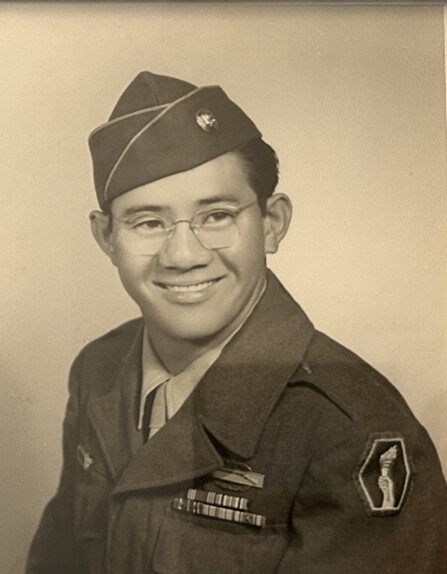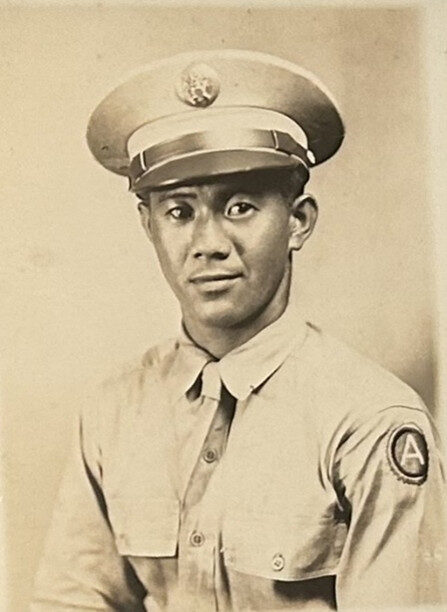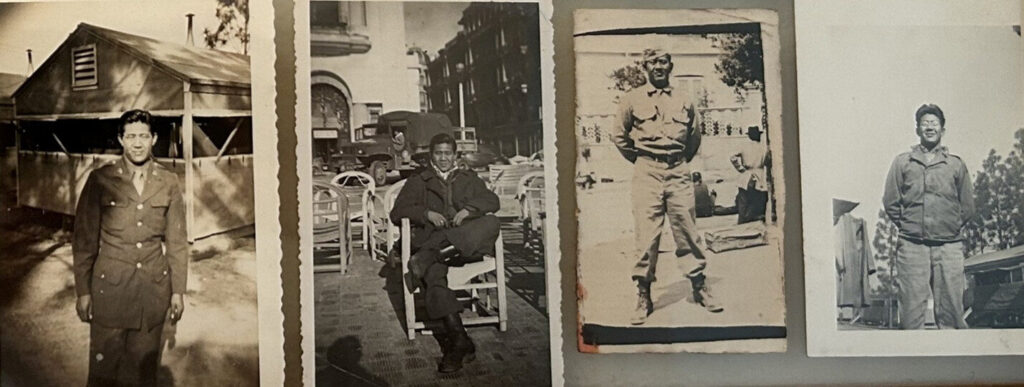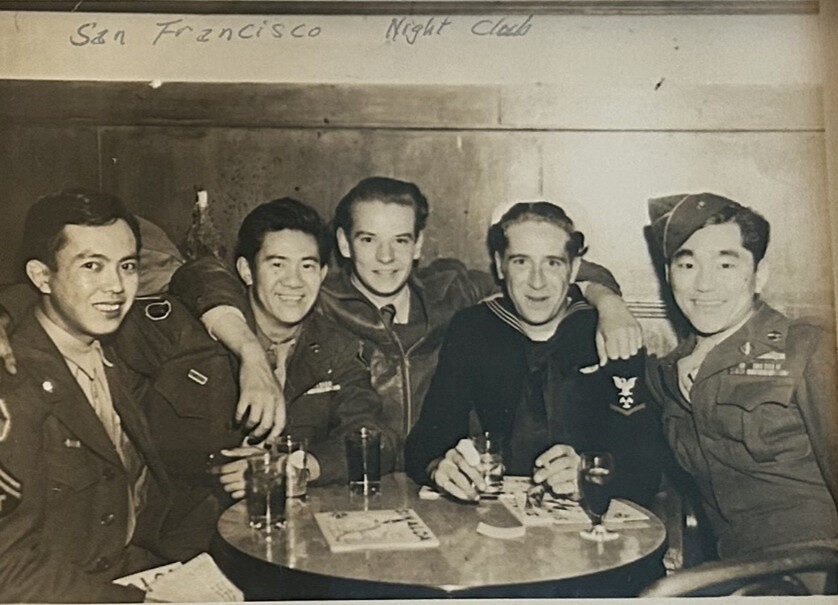Soldier Story: Thomas Masaichi Inouye
Soldier Story

Thomas Masaichi Inouye
Private First Class
442nd Regimental Combat Team
Cannon Company
Thomas Masaichi Inouye was born on February 18, 1923, in Honolulu, Territory of Hawaii. His parents were Seitaro and Tsui (Tsubaki) Inouye, who emigrated from Fukuoka Prefecture, Japan. His siblings were: brothers James Shigeru, Harry Fukujiro, Richard Toshio, Harold Masaru; and sisters Hazel Nobuko, Haruko, Florence Hatsumi, Louise Yaeno, and Doris Hitomi. Seitaro arrived in Honolulu from Japan on the Sagami Maru on June 17, 1890, at the age of 23.
Seitaro and Tsui married on April 2, 1911, a few days after her arrival in Honolulu. She was a “picture bride” and this was Seitaro’s second marriage. In 1918, when Seitaro signed his World War I draft registration card, the family was living on Oili Road in the Kahala area of Honolulu. Seitaro was employed as a yardman for a private family. His contact address was the Okasago Store in Waikiki. After his brother Mantaro died in 1930 and Mantaro’s wife Koyono died in 1931, he “adopted” their children. Mantaro had raised chickens and pigs on his property on Oili Road. Seitaro then died in 1937, leaving all of the children with only Tsui to care for them.
In 1940, Tom was living with his widowed mother Tsui, his elder half-brother Harry, Harry’s wife Kiyono, and their daughter Mary M. They lived on Oili Road. Tom was a carpenter for a private family.
On June 30, 1942, Tom signed his World War II draft registration card, Local Board No. 2, at 3563 Waialae Avenue. His residence was Box 1377, Oili Road and his point of contact was Yoshito Fujioka, who also lived on Oili Road. He was working for Ben Hayashi, a contractor. Tom was 5’3½” tall and weighed 120 pounds.
Tom Inouye enlisted in the U.S. Army on March 24, 1943, and was sent to the “tent city” known as Boom Town at Schofield Barracks. On March 28, the new soldiers of the 442nd Regimental Combat Team were given a farewell ceremony by the community at Iolani Palace. On April 4 they sailed on the S.S. Lurline for California. Upon arrival in Oakland, the 2,686 men were sent by train to Camp Shelby, Mississippi, for training.

Basic training took place from May 10 to August 23. After a brief break – during which the men had time for short passes and furloughs – they returned to camp and unit training was ready to begin.
Right: Inouye while at Camp Shelby
The 442nd had decided to activate a Cannon Company at the regimental level, and this occurred on September 3. Six officers were chosen, and they selected 150 men from other companies to transfer to the new Cannon Company. Private Thomas M. Inouye was among that group – we do not know his initial company assignment prior to Cannon Company.
Cannon Company consisted of six light, truck-drawn, 105mm howitzers. This gave the regimental commander his own artillery that he could use when the Combat Team’s 522nd Field Artillery Battalion was firing another mission or needed additional support. Cannon Company could shoot also under the direction of the 522nd’s Fire Direction Center as an extra firing battery.
After nearly a year of training and field maneuvers, the 442nd left Camp Shelby on April 22, 1944, by train for Camp Patrick Henry, Virginia. On May 2, they sailed from nearby Hampton Roads in a convoy of over 100 ships bound for the Theater of War.
After a lengthy crossing, the 442nd arrived at Naples, Italy, on May 28 to join in the Rome-Arno Campaign. After two weeks at Staging Area No. 4, their bivouac area in nearly Bagnoli, they left on LSTs and LCIs (Landing Ship, Tank and Landing Craft, Infantry) on June 6 and arrived at the recently liberated Anzio beachhead the next day. Finally, on June 9 they headed out in a truck convoy through the recently liberated city of Rome for their large bivouac area at Civitavecchia, about 50 miles north. There they made final preparations to advance to the front lines.
Below: Stone box inscribed by Thomas, “Thomas M. Inouye, 1944, Italy”

The 442nd, with Private Inouye, entered combat in the Rome-Arno Campaign on June 26, 1944, near Suvereto. They encountered some heavy fighting as they steadily pushed the Germans up the Italian peninsula. After driving the enemy north to the Arno River, they were pulled from the lines and sent to Naples for shipment to France, where they joined in the Rhineland-Vosges Campaign. They arrived at Marseilles on September 29 after a 2-day voyage, and bivouacked at nearby Septèmes prior to traveling over 500 miles north by truck or rail boxcars to the Vosges Mountains.
Inouye was in combat for the next month during the bitter fighting to liberate the important rail and road junction of Bruyères, neighboring Biffontaine and Belmont, and the “Rescue of the Lost Battalion” – the 1st Battalion, 141st (Texas) Infantry that had advanced beyond the lines and was surrounded on three sides by the enemy. The weather was cold, wet, snowy, and miserable, as the men fought in the heavily wooded forests still in their summer uniforms. They were subjected to living in foxholes, and incoming artillery raining down on them in “tree bursts.”
After the fierce fighting and heavy casualties in the Vosges, the 442nd was now at half strength, and was sent to the south of France. There, they could rebuild to full combat strength while participating in the Rhineland-Maritime Alps Campaign, which was mostly a defensive position guarding the French-Italian border from incursion by the German Army in Italy.
Below: Thomas at (left to right) Camp Shelby, Nice, Italy, Camp Shelby

The 442nd was in southern France from November 23, 1944, until March 15, 1945, when they were relieved and moved to the new staging area at Marseilles. On March 20-22, the 442nd (without its 522nd Field Artillery Battalion who were sent to Germany) left France to fight in the Po Valley Campaign for the final push to defeat the Nazis in Italy. They arrived at the Peninsular Base Section in Pisa on March 25 and were assigned to the 92nd Division, Fifth Army.
The objective of the 442nd was to execute a surprise diversionary attack on the western anchor of the German Gothic Line. This elaborate system of fortifications had been attacked in the fall of 1944, but no one had yet been able to pry the Germans loose from the western end. The Gothic Line in this area was hewn out of solid rock, reinforced with concrete, and constructed to give all-around protection and observation. The Germans were dug into mountain peaks rising almost sheer from the coastal plain, bare of vegetation save for scanty scrub growth.
The Combat Team left their initial staging area and moved to a bivouac at San Martino, near the walled city of Lucca. Starting on April 3, the 442nd conducted a surprise attack on the Germans at Mount Folgorito. Within 90 minutes, the 442nd cracked the Gothic Line, which had withstood five months of attempts by the 92nd Division.
The 442nd’s attack was relentlessly pursued by the Combat Team, finally taking Aulla on April 25, resulting in a complete breakthrough of the Gothic Line in the west. The 442nd penetrated as far north as Torino The divisionary attack succeeded in drawing off Nazi reserve forces from the center of the Gothic Line, enabling the Allied forces to break through the center of the Gothic Line. Despite orders from Hitler to fight on, the German forces in Italy surrendered on May 2, 1945, a week before the rest of the German forces in Europe surrendered.
Pfc. Inouye was with the 442nd while on occupation duty at Ghedi Air Field guarding and processing German prisoners, the move to Lecco, and the return to the Livorno/Pisa/Florence area on July 12 for further guard duty. Tom remained in Italy until later in 1945.
Below: With buddies in a night club in San Francisco enroute home, 1945, Thomas is second from the left.

Inouye left Europe the end of October 1945 for the US. He arrived back to Honolulu on December 16, 1945, on the USAT Aconcagua at Pier 26 at 9:00 a.m. Thousands of friends and family were there with lei and gifts to meet the more than 500 soldiers, but they were held back from the pier while the Army quickly loaded the men onto waiting busses and took them to the Army Separation Center at Fort Kamehameha for processing. They were then given time off with orders to return later for discharge. Pfc. Inouye was discharged from the U.S. Army on December 24.
For his World War II service, Private First Class Thomas Masaichi Inouye was awarded the: Bronze Star Medal, Good Conduct Medal, European-African-Middle Eastern Campaign Medal with four bronze stars, World War II Victory Medal, Army of Occupation Medal, Distinguished Unit Badge, and Combat Infantryman Badge. He was posthumously awarded the Congressional Gold Medal on October 5, 2010, along with the other veterans of the 442nd Regimental Combat Team. Conferred by the U.S. Congress, the award states: “The United States remains forever indebted to the bravery, valor, and dedication to country these men faced while fighting a 2-fronted battle of discrimination at home and fascism abroad. Their commitment and sacrifice demonstrates a highly uncommon and commendable sense of patriotism and honor.ˮ
Thomas married Betty Masae Nakaji in 1949 and they lived with his mother and brother Harry at 4120 Alaea Place. By 1950 they had moved to 1008-C Kalo Lane and he was a carpenter for a general contractor. They later divorced and he married Nancy Fusae Asato, the daughter of Kasuke and Hatsuno Asato. Over the years, he and his wife raised a family of one son and two daughters. Tom Inouye retired from Pearl Harbor Public Works Center.
Thomas M. Inouye died on December 1, 2001, in Honolulu. He was buried in the Hawaii State Veterans Cemetery in Kaneohe, Section 50, Row L, Grave 3. His tombstone is engraved “You will be remembered.” Survivors included his wife, son and two daughters, seven grandchildren, brothers Harry, Richard, and Harold, and sisters Hazel Siu, Haruko Nomura, Florence Hatsumi Kurihara, and Louise Yaeno Kinoshita. His sister Doris Hitomi Takenishi predeceased him on November 30, 1991.
Researched and written by the Sons & Daughters of the 442nd RCT with assistance by the family in 2025.